Exploring SiC Planar IGBTs towards Enhanced Conductivity Modulation Comparable to SiC Trench IGBTs
Abstract
:1. Introduction
2. Device Structure and Proposed Process Flow
3. Device Characteristics
4. Conclusions
Author Contributions
Funding
Conflicts of Interest
References
- Kimoto, T.; Cooper, J.A. Fundamentals of Silicon Carbide Technology: Growth, Characterization, Devices and Applications; Wiley: Singapore, 2014. [Google Scholar]
- Capan, I.; Yamazaki, Y.; Oki, Y.; Brodar, T.; Makino, T.; Ohshima, T. Minority carrier trap in n-type 4H–SiC Schottky barrier diodes. Crystals 2019, 9, 328. [Google Scholar] [CrossRef] [Green Version]
- Lebedev, A.A.; Ber, B.Y.; Seredova, N.V.; Kazantsev, D.Y.; Kozlovski, V.V. Radiation-stimulated photoluminescence in electron irradiated 4H-SiC. J. Phys. D Appl. Phys. 2015, 48, 485106. [Google Scholar] [CrossRef]
- Daviau, K.; Lee, K.K.M. High-performance, high-temperature behavior of silicon carbide: A review. Crystals 2018, 8, 217. [Google Scholar] [CrossRef] [Green Version]
- Tiwari, A.K.; Antoniou, M.; Lophitis, N.; Perkins, S.; Udrea, F. Retrograde p-well for 10-kV class SiC IGBTs. IEEE Trans. Electron Devices 2019, 66, 3066–3072. [Google Scholar] [CrossRef]
- Brunt, E.V.; Cheng, L.; O’Loughlin, M.; Capell, C.; Jonas, C.; Lam, K.; Richmond, J.; Pala, V.; Ryu, S.; Allen, S.T.; et al. 22 kV 1 cm2 4H-SiC n-IGBTs with improved conductivity modulation. In Proceedings of the ISPSD, Waikoloa, HI, USA, 15–19 June 2014; pp. 358–361. [Google Scholar]
- Ryu, S.; Capell, C.; Jonas, C.; Cheng, L.; O’Loughlin, M.; Burk, A.; Agarwal, A.; Palmour, J.; Hefner, A. Ultra high voltage (>12 kV), high performance 4H-SiC IGBTs. In Proceedings of the ISPSD, Bruges, Belgium, 3–7 June 2012; pp. 257–260. [Google Scholar]
- Vechalapu, K.; Bhattacharya, S.; Van Brunt, E.; Ryu, S.; Grider, D.; Palmour, J.W. Comparative evaluation of 15-kV SiC MOSFET and 15-kV SiC IGBT for medium-voltage converter under the same dv/dt conditions. IEEE J. Emerg. Sel. Top. Power Electron 2017, 5, 469–489. [Google Scholar] [CrossRef]
- Kitagawa, M.; Omura, I.; Hasegawa, S.; Inoue, T.; Nakagawa, A. A 4500 V injection enhanced insulated gate bipolar transistor (IEGT) operating in a mode similar to a thyristor. In Proceedings of the IEEE International Electron Devices Meeting, Washington, DC, USA, 5–8 December 1993; pp. 679–682. [Google Scholar]
- Zhang, Q.; Chang, H.; Gomez, M.; Bui, C.; Hanna, E. 10 kV trench gate IGBTs on 4H-SiC. In Proceedings of the ISPSD, Santa Barbara, CA, USA, 23–26 May 2005; pp. 303–306. [Google Scholar]
- Zhang, M.; Wei, J.; Jiang, H.; Chen, K.J.; Cheng, C. SiC trench MOSFET with self-biased p-shield for low RON-SP and low OFF-state oxide field. IET Power Electron 2017, 10, 1208–1213. [Google Scholar] [CrossRef]
- Matsunaga, S.; Mizushima, T. Low Von 17kV SiC IGBT assisted n-MOS thyristor. In Proceedings of the IEEE International Electron Devices Meeting (IEDM), San Francisco, CA, USA, 7–11 December 2019; pp. 474–477. [Google Scholar]
- Synopsys. TCAD Sentaurus Device Manual; Synopsys Inc.: Mountain View, CA, USA, 2013. [Google Scholar]
- An, J.; Namai, M.; Tanabe, M.; Okamoto, D.; Yano, H.; Iwamuro, N. Experimental demonstration of −730V vertical SiC p-MOSFET with high short circuit withstand capability for complementary inverter applications. In Proceedings of the IEEE International Electron Devices Meeting (IEDM), San Francisco, CA, USA, 3–7 December 2016; pp. 272–275. [Google Scholar]
- Usman, M.; Nawaz, M. Device design assessment of 4H–SiC n-IGBT—A simulation study. Solid-State Electron. 2014, 92, 5–11. [Google Scholar] [CrossRef]
- Uchida, K.; Saitoh, Y.; Hiyoshi, T.; Masuda, T.; Wada, K.; Tamaso, H.; Hatayama, T.; Hiratsuka, K.; Tsuno, T.; Furumai, M.; et al. The optimised design and characterization of 1200 V/2.0 mΩ cm2 4H-SiC V-groove trench MOSFETs. In Proceedings of the ISPSD, Hong Kong, China, 10–14 May 2015; pp. 85–88. [Google Scholar]
- Nishio, J.; Ota, C.; Hatakeyama, T.; Shinohe, T.; Kojima, K.; Nishizawa, S.; Ohashi, H. Ultralow-loss SiC floating junction Schottky barrier diodes (super-SBDs). IEEE Trans. Electron Devices 2008, 55, 1954–1960. [Google Scholar] [CrossRef]
- Sumitomo, M.; Sakane, H.; Arakawa, K.; Higuchi, Y.; Matsui, M. Injection control technique for high speed switching with a double gate PNM-IGBT. In Proceedings of the ISPSD, Kanazawa, Japan, 26–30 May 2013; pp. 33–36. [Google Scholar]
- Zerarka, M.; Austin, P.; Bafleur, M. Comparative study of sensitive volume and triggering criteria of SEB in 600 V planar and trench IGBTs. Microelectron. Reliab. 2011, 51, 1990–1994. [Google Scholar] [CrossRef]
- Matocha, K.; Dunne, G.; Soloviev, S.; Beaupre, R. Time-dependent dielectric breakdown of 4H-SiC MOS capacitors and DMOSFETs. IEEE Trans. Electron Devices 2008, 55, 1830–1834. [Google Scholar] [CrossRef]
- Wei, J.; Zhang, M.; Jiang, H.; Wang, H.; Chen, K.J. Dynamic degradation in SiC trench MOSFET with a floating p-shield revealed with numerical simulations. IEEE Trans. Electron Devices 2017, 64, 2592–2598. [Google Scholar] [CrossRef]
- Takaya, H.; Miyagi, K.; Hamada, K. Floating islands and thick bottom oxide trench gate MOSFET (FITMOS) with passive hole gate. In Proceedings of the International Electron Devices Meeting, San Francisco, CA, USA, 11–13 December 2006; pp. 1–4. [Google Scholar]
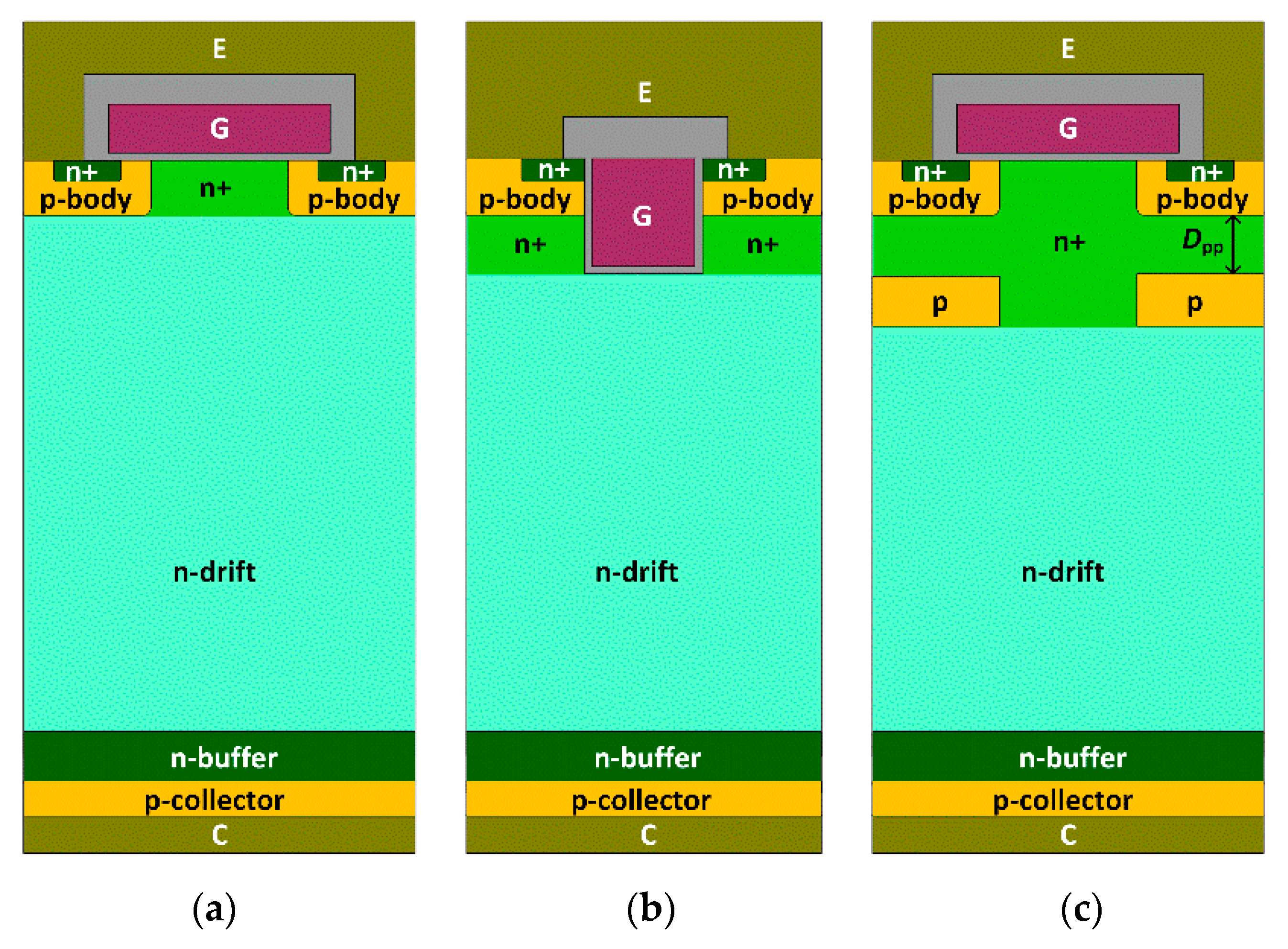
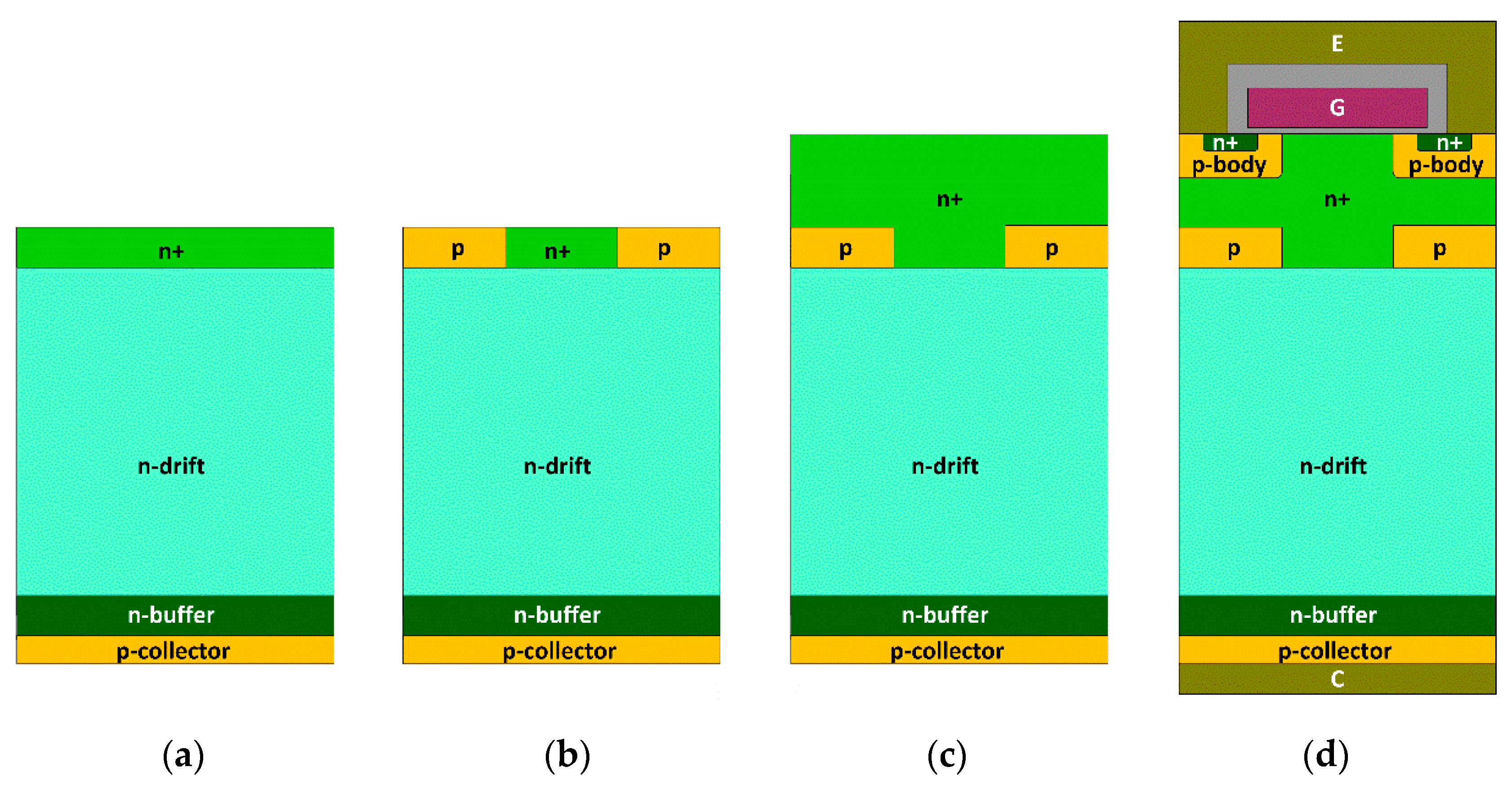
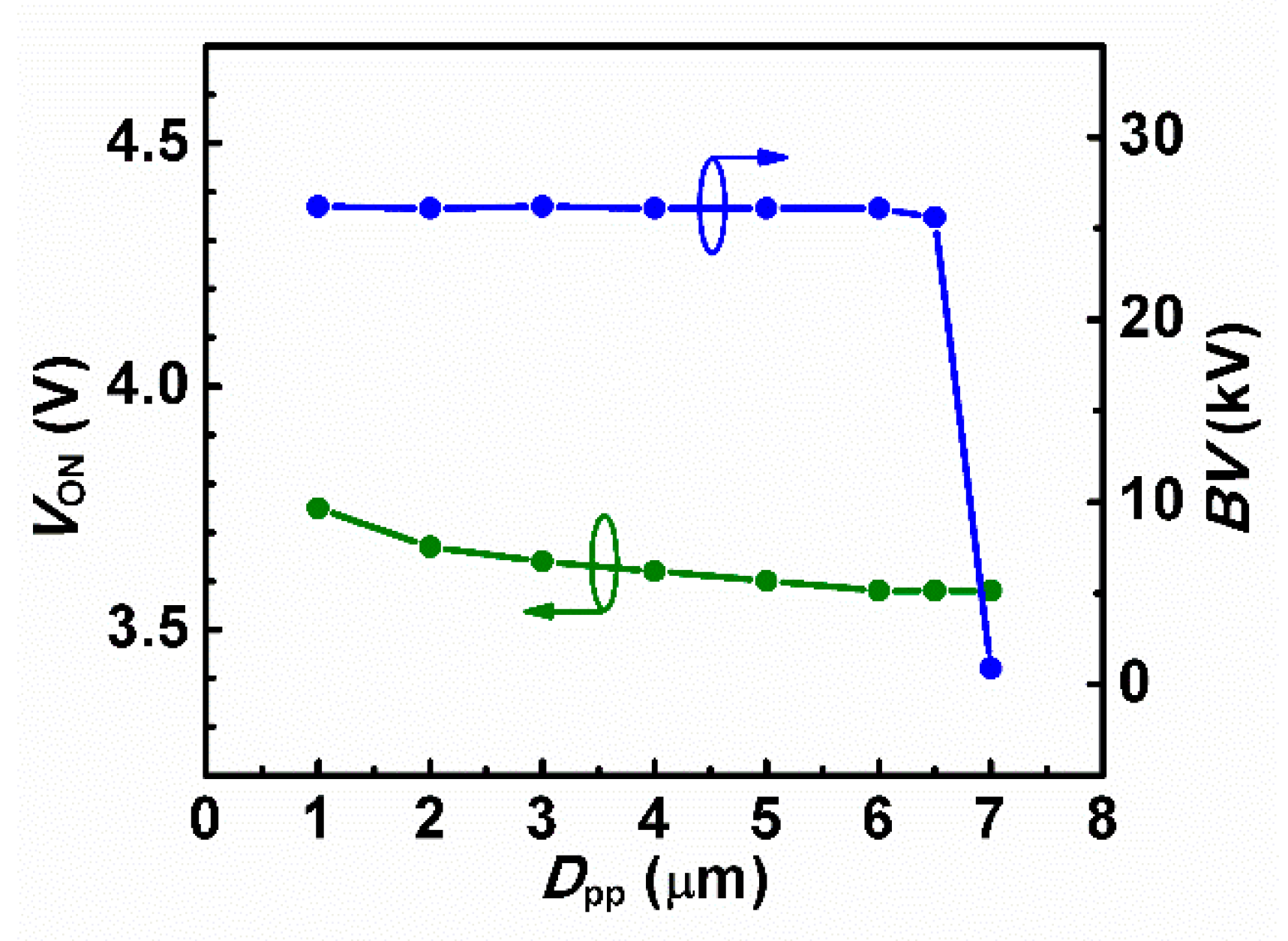
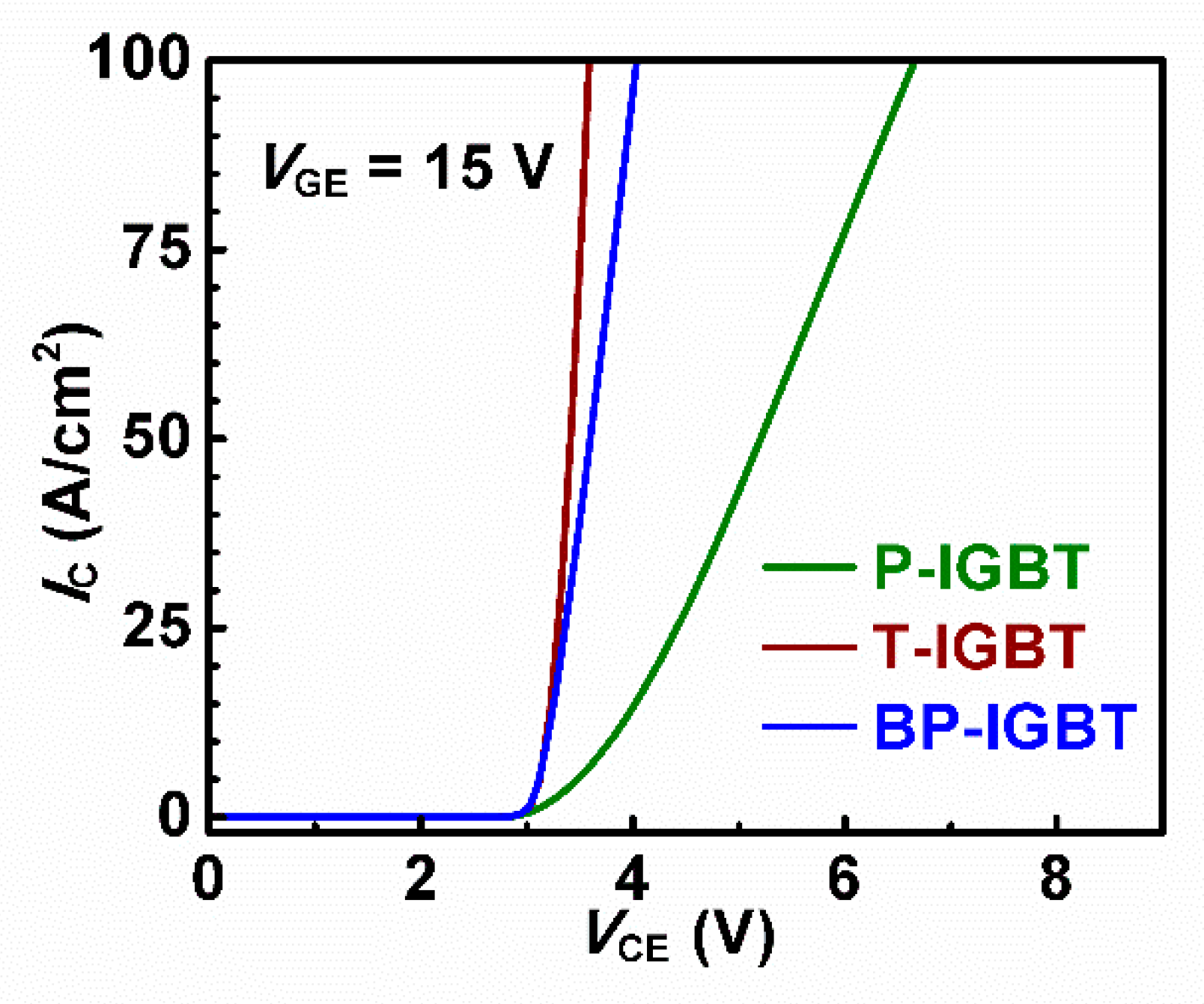
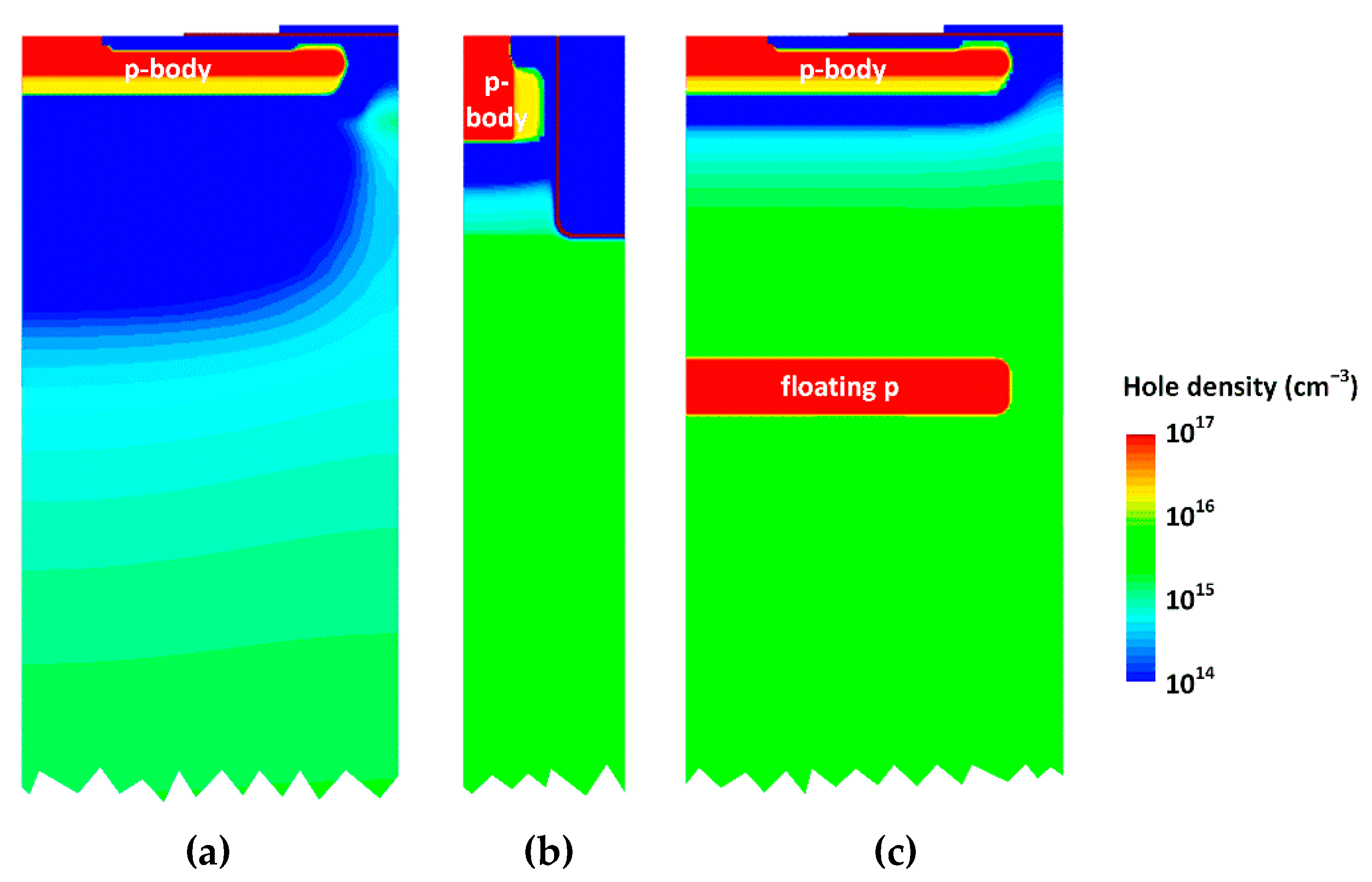
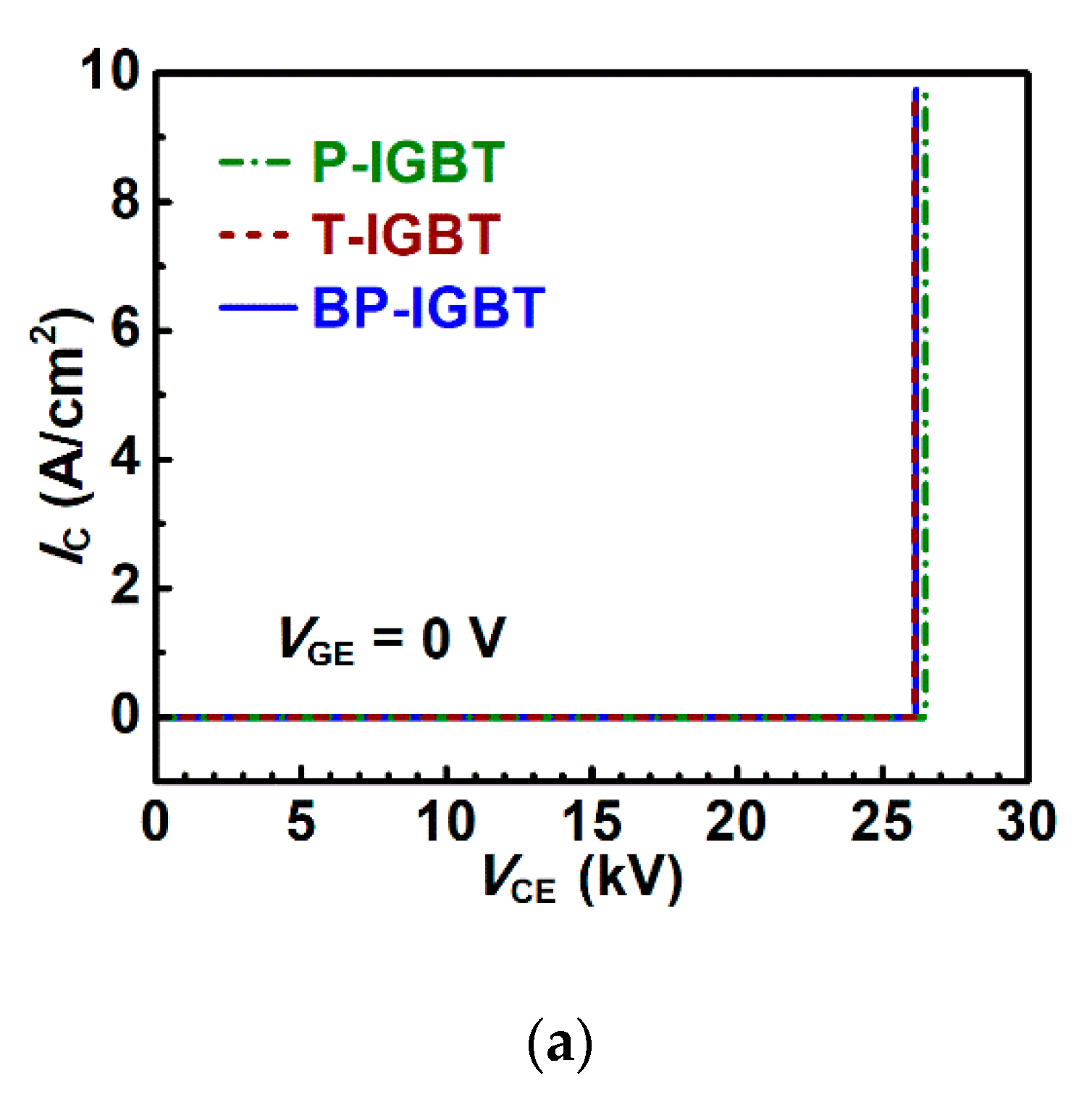
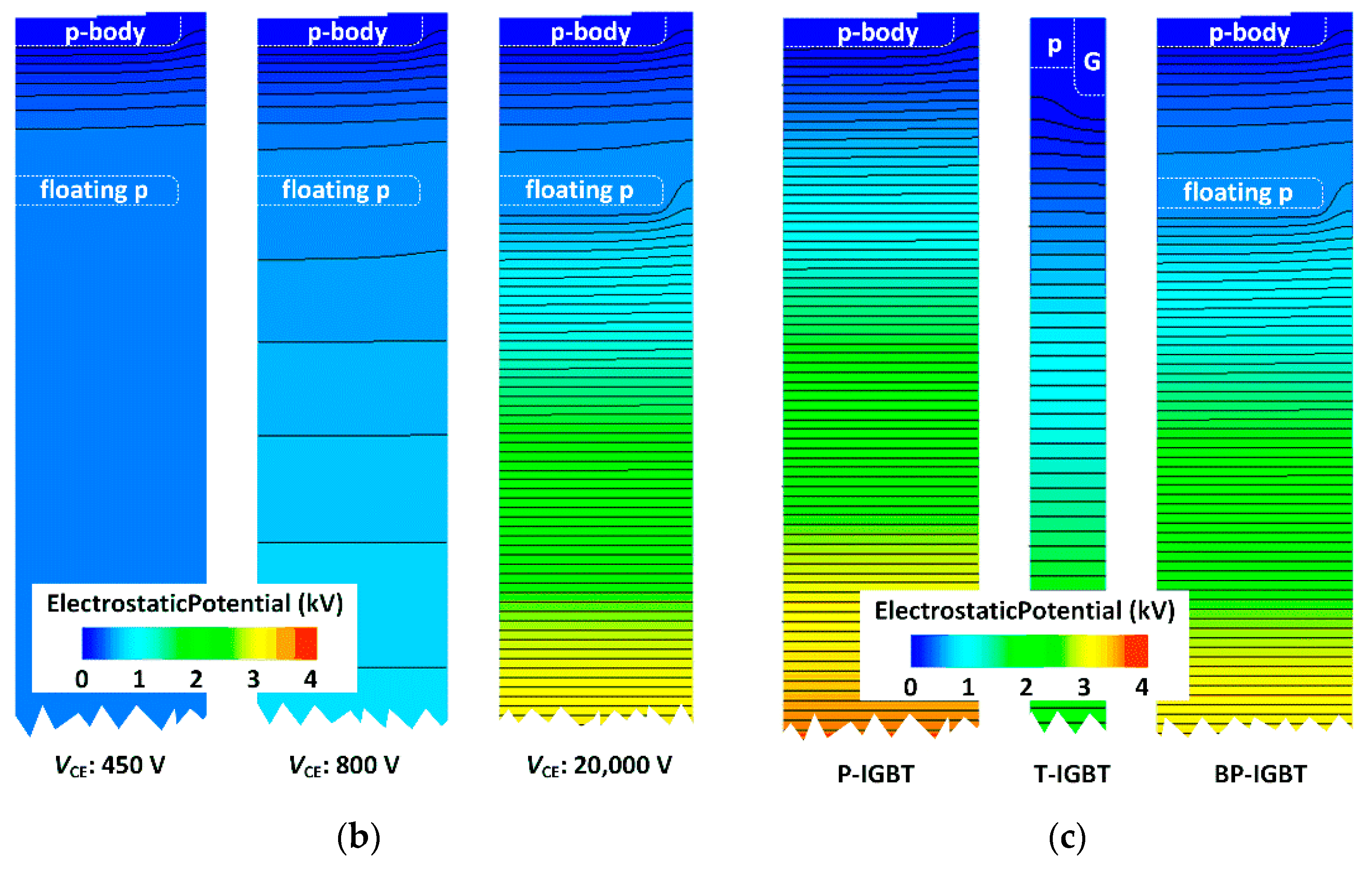
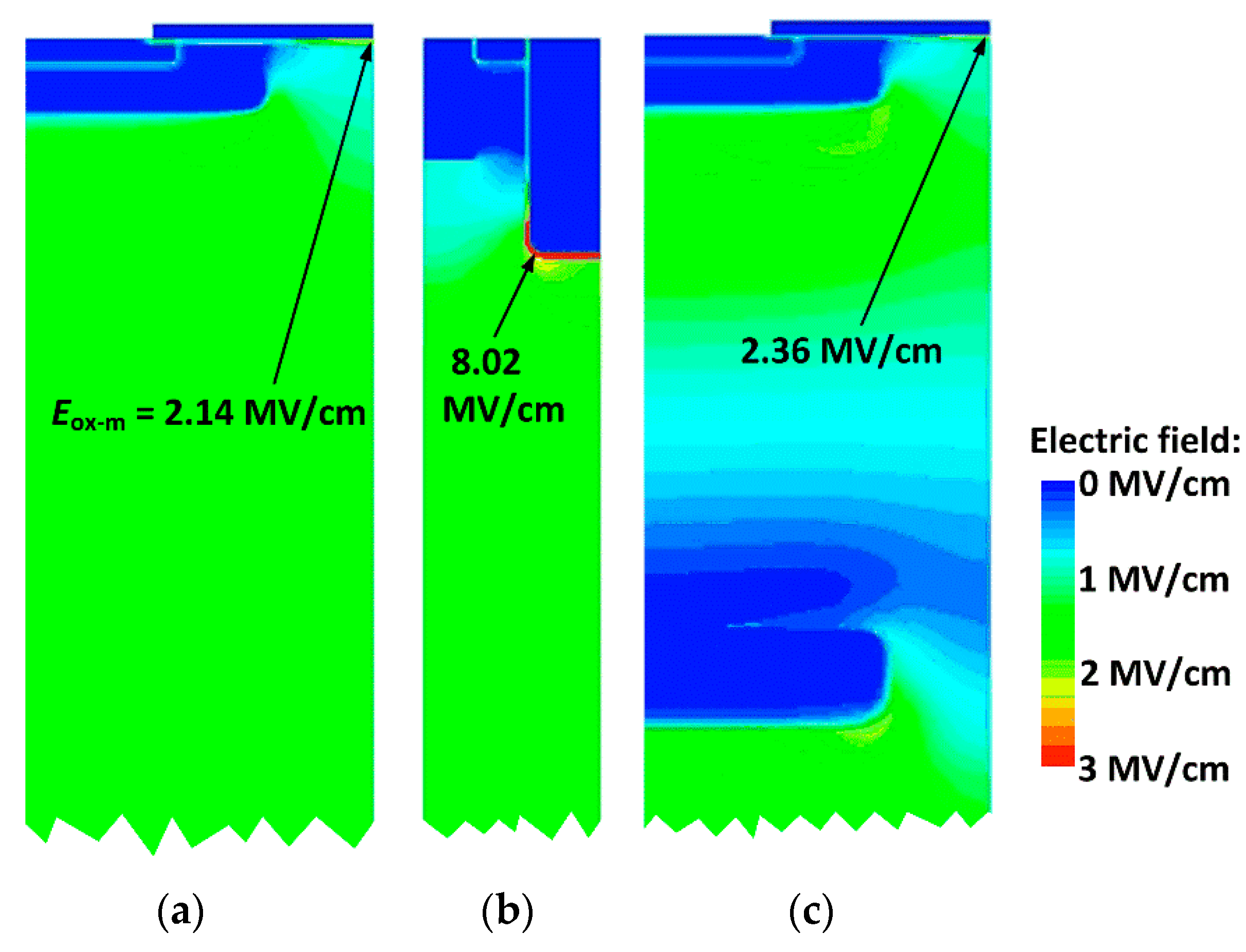
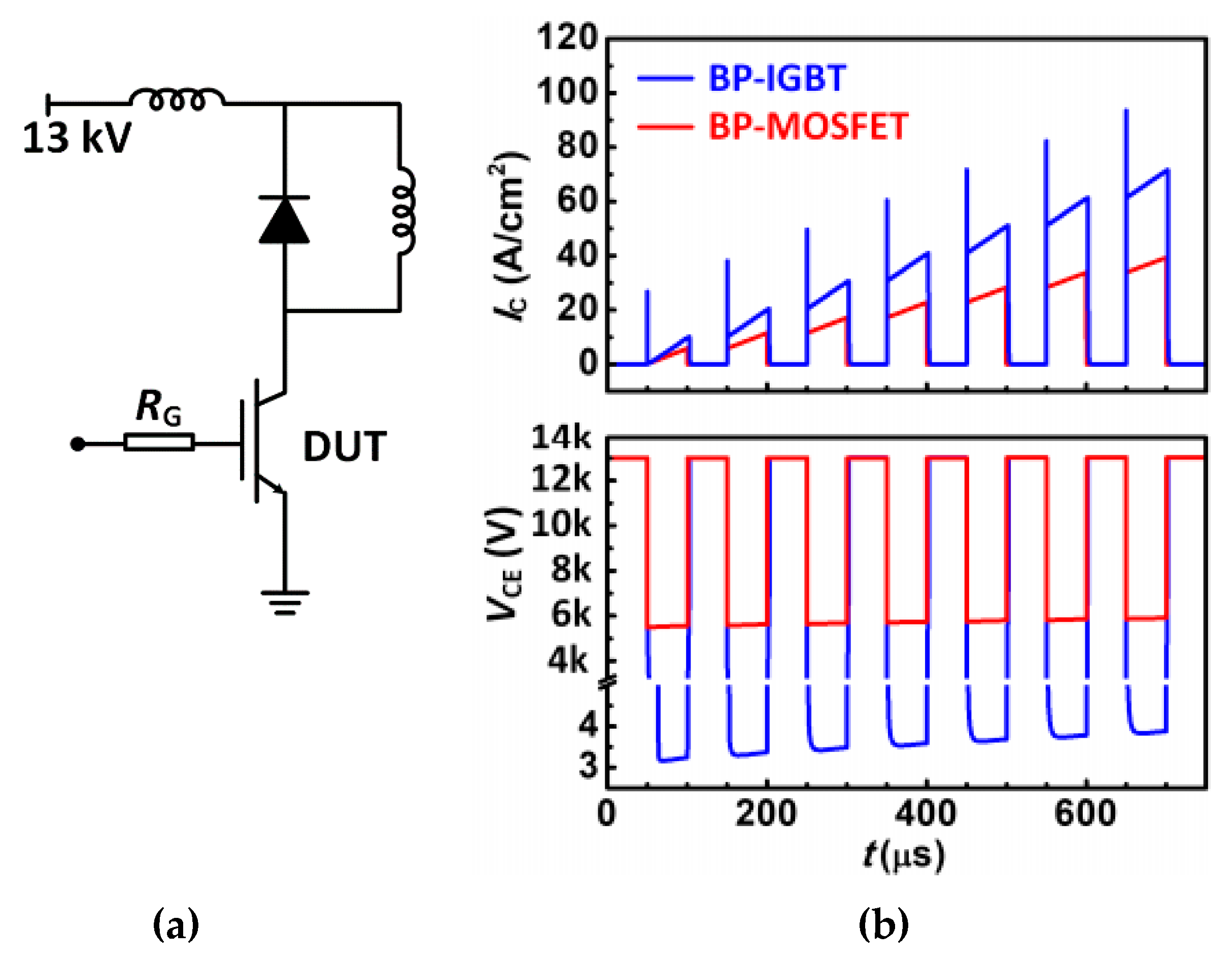
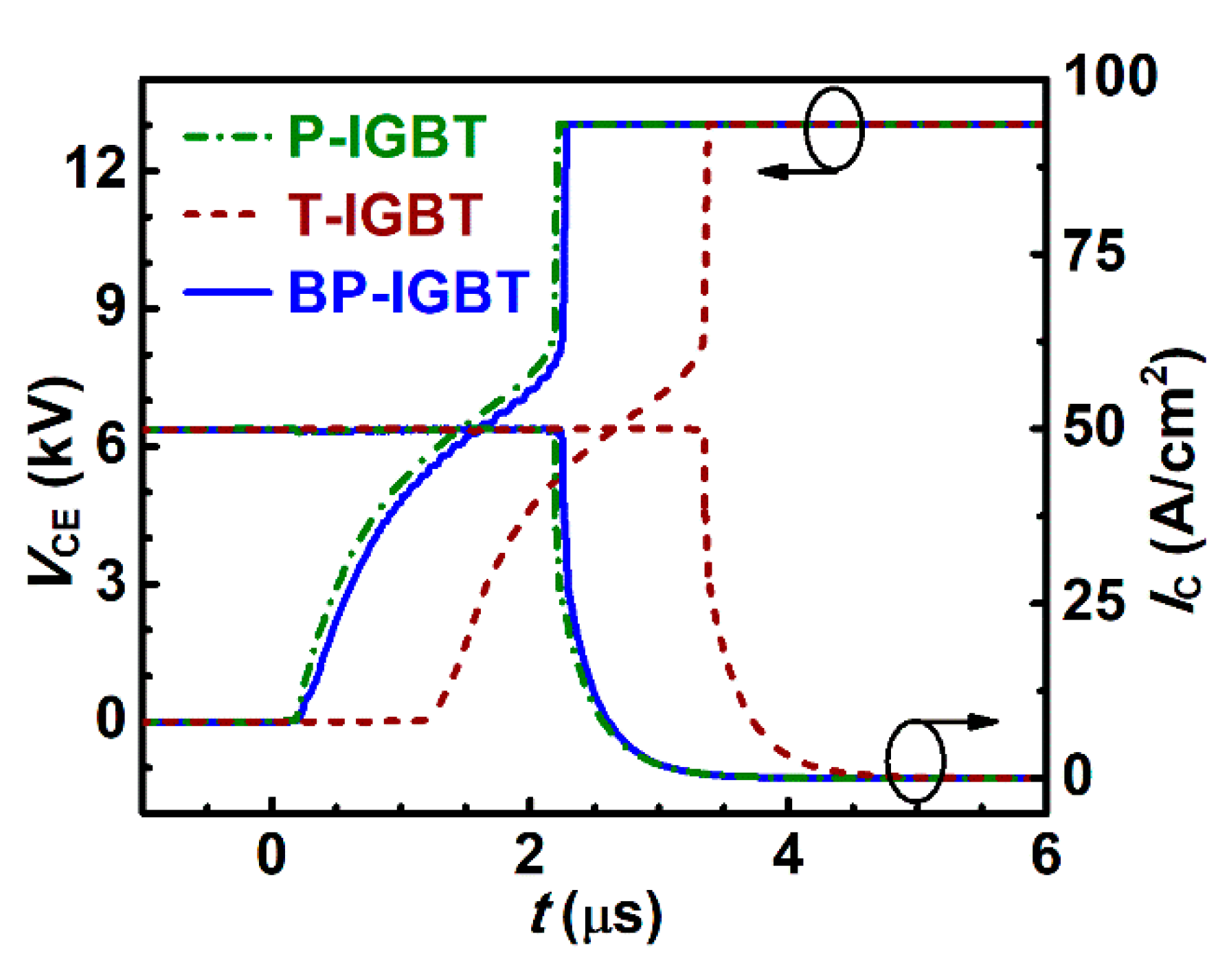
| Parameter | P-IGBT | T-IGBT | BP-IGBT | Unit |
|---|---|---|---|---|
| n-drift thickness | 180 | 180 | 180 | μm |
| n-drift doping | 2.5 × 1014 | 2.5 × 1014 | 2.5 × 1014 | cm−3 |
| gate oxide thickness | 50 | 50 | 50 | nm |
| n+-emitter thickness | 0.2 | 0.2 | 0.2 | μm |
| n+-emitter doping | 5 × 1019 | 5 × 1019 | 5 × 1019 | cm−3 |
| p-body thickness | 1.0 | 1.2 | 1.0 | μm |
| p-body doping | 1 × 1017 | 1 × 1017 | 1 × 1017 | cm−3 |
| cell pitch | 14 | 3.5 | 14 | μm |
| carrier lifetime | 2.0 | 2.0 | 2.0 | μs |
| n+-region doping | 2 × 1016 | 2 × 1016 | 2 × 1016 | cm−3 |
| thickness of buried p-layer | n/a | n/a | 1 | μm |
| buried p-layer doping | n/a | n/a | 1 × 1018 | cm−3 |
| n-buffer thickness | 10 | 10 | 10 | μm |
| n-buffer doping | 4 × 1017 | 4 × 1017 | 4 × 1017 | cm−3 |
| p-collector thickness | 5 | 5 | 5 | μm |
| p-collector doping | 1 × 1019 | 1 × 1019 | 1 × 1019 | cm−3 |
| P-IGBT | T-IGBT | BP-IGBT | Unit | |
|---|---|---|---|---|
| VON | 5.2 | 3.4 | 3.6 | V |
| BV | 26.5 | 26.09 | 26.15 | kV |
| Eox-m | 2.14 | 8.02 | 2.36 | MV/cm |
| EOFF | 0.65 | 0.65 | 0.62 | J/cm2 |
© 2020 by the authors. Licensee MDPI, Basel, Switzerland. This article is an open access article distributed under the terms and conditions of the Creative Commons Attribution (CC BY) license (http://creativecommons.org/licenses/by/4.0/).
Share and Cite
Zhang, M.; Li, B.; Wei, J. Exploring SiC Planar IGBTs towards Enhanced Conductivity Modulation Comparable to SiC Trench IGBTs. Crystals 2020, 10, 417. https://doi.org/10.3390/cryst10050417
Zhang M, Li B, Wei J. Exploring SiC Planar IGBTs towards Enhanced Conductivity Modulation Comparable to SiC Trench IGBTs. Crystals. 2020; 10(5):417. https://doi.org/10.3390/cryst10050417
Chicago/Turabian StyleZhang, Meng, Baikui Li, and Jin Wei. 2020. "Exploring SiC Planar IGBTs towards Enhanced Conductivity Modulation Comparable to SiC Trench IGBTs" Crystals 10, no. 5: 417. https://doi.org/10.3390/cryst10050417
APA StyleZhang, M., Li, B., & Wei, J. (2020). Exploring SiC Planar IGBTs towards Enhanced Conductivity Modulation Comparable to SiC Trench IGBTs. Crystals, 10(5), 417. https://doi.org/10.3390/cryst10050417




